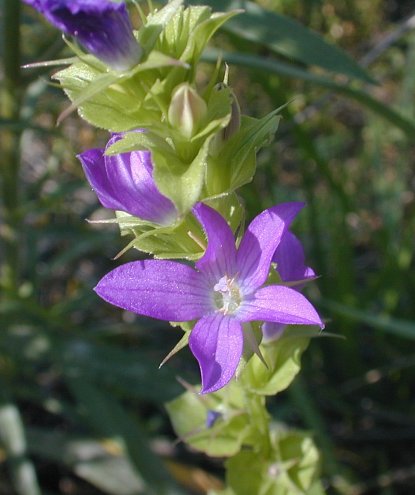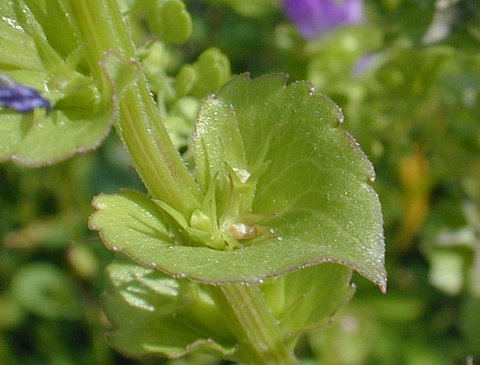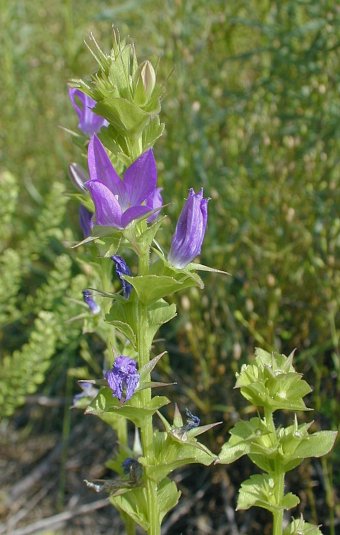Description: This annual plant is unbranched. It is usually 4-12" tall, and rarely becomes taller. The central stem is light green and deeply grooved, with lines of small white hairs along the ridges. The alternate leaves are also light green, and strongly clasp the stem. However, at the top of the stem are a pair of opposite leaves. These leaves are up to 1" long and nearly as wide. They are broadly cordate, with wavy or dentate margins that are slightly ciliate. Along the margins, the leaves may assume a purplish color in bright sunlight. There is a milky sap in both the stem and leaves. From each leaf axil in the upper half of the plant, are 1-3 flowers, although only one of these will be in bloom at the same time. Each flower is deep violet or purple and about ½" across. It has a short tubular corolla with 5 spreading lobes. There are darker lines of purple that converge toward the throat of the flower. The throat is whiter than the rest of the flower, from which emerges a prominent white pistil and several stamens.

The blooming
period occurs during the early summer and lasts about a month. There is
no floral fragrance. This plant also produces self-pollinating flowers
on the lower half of the stem, whose petals never open. The ovaries
develop into small oval capsules, which split open into 3 parts to
about the middle. This releases the numerous tiny seeds, which are
lens-shaped and reddish brown. They are dispersed readily by the wind,
and can be carried a considerable distance. The root system consists of
a taproot.
Cultivation:
The preference is full sunlight, and mesic to slightly dry soil. This
plant flourishes best in poor soil that is either gravelly or sandy. It
doesn't tolerate much competition from taller plants. Foliar disease is
not a significant problem during the period of active growth and
blooming, after which this plant will fade away.

Range &
Habitat:
The native Venus' Looking Glass is fairly common in the southern half
of Illinois,
but uncommon or absent in many areas of the northern half (see Distribution
Map). Habitats include mesic to slightly dry sand prairies,
gravel prairies, upland areas of black soil prairies, sandy savannas,
lake borders, abandoned fields, and areas along railroads and
roadsides, especially where it is gravelly or sandy. The habitats where
this plant occurs have sparser and lower vegetation than many other
areas as a result of poor soil or disturbance.
Faunal Associations:
Small bees are the most common visitors of the flowers. This includes
Little Carpenter bees, Plasterer bees, Green Metallic bees, and other
Halictine bees. The Plasterer bee Colletes brevicornis
is an oligolege of Venus' Looking Glass. Other insect visitors include
bumblebees, flies, small butterflies, and skippers. The seeds are too
small to be of any interest to birds. Mammalian herbivores may consume
this plant, although it is of minor importance as a food source.

Photographic
Location:
The photographs were taken in a waste area along a gravel road near
Champaign, Illinois.
Comments:
When it is sunny, the flowers open up during the morning, and remain
open for the rest of the day. They are attractive, but rather small.
The common name of this plant probably refers to the shiny seeds of a
related European species. The seeds of Venus' Looking Glass are too
tiny to appear shiny to the unaided human eye. In form and color, the
flowers of this plant resemble the flowers of Campanula
americana (Tall Bellflower), but the former are much smaller.
An older scientific name for this plant is Specularia
perfoliata.